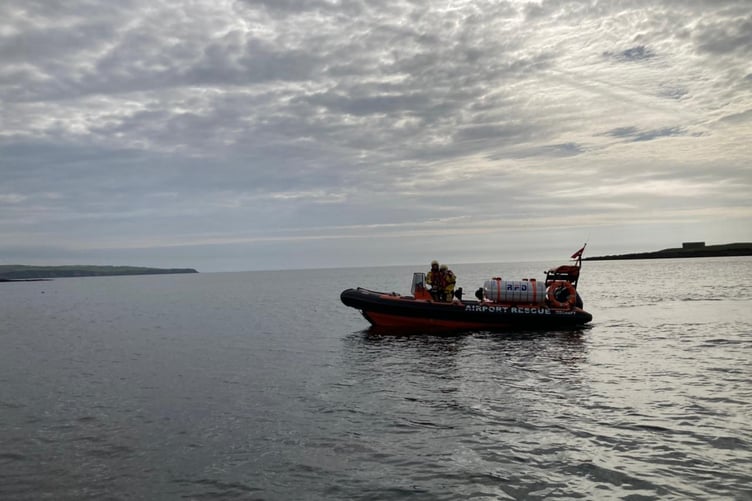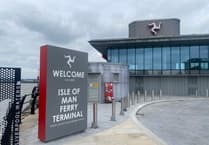Disclosed costs related to an aircraft rescue boat have topped £285,000.
A recent Freedom of Information response has now shed more light on the airport inshore rescue boat.
The vessel is operated by the Isle of Man Airport Fire and Rescue Service, which falls under the Department of Infrastructure (DoI).
Based at Ronaldsway airport, it’s designed to enable a swift response to incidents at sea where life-rafts have to be deployed.
But it has not been operational since it was bought due to the level of training required, according to the DoI.
At present, should a plane ‘ditch’ into the sea, there are two agreements in place with the Isle of Man Coastguard and the Royal National Lifeboat Institute (RNLI) along with the Maritime Coastguard Agency to aid in the rescue, according to Infrastructure Minister, Tim Crookall.
According to the DoI, there are no costs incurred with this arrangement.
The Airport Inshore Rescue Boat (IRB) was bought for £87,057 in October 2019 to replace an older vessel which was decommissioned in 2016.
Asked about the decision-making behind the new vessel, the DoI spokesperson said: ‘As a certified aerodrome, Isle of Man Airport is required to address the aviation safety risks of its operations with regard to the local environment.
‘As part of this, the Airport is required to assess approach and departure areas within 1000-metre of each runway threshold to determine the options available for intervention in an emergency.
‘Particular attention must be given to the hazards brought about by aircraft approach and departure operations over water and this may require the development of special procedures or provision of specialist rescue equipment.
‘Whilst there is no explicit regulatory requirement to provide a rescue boat, the Airport must ensure that appropriate procedures and equipment are available to effect a rescue on the water, be they provided by the Airport itself or under an agreement entered into with a third party.
‘Regulatory guidance material recognises that suitably located and equipped public or private organisations could be designated to provide specialist equipment, and that any rescue may require the use of equipment and personnel other than those assessed primarily for rescue and firefighting purposes.
‘The shift towards collaborating with external agencies is not exclusive to the Isle of Man; there is a recent trend among airports to move away from self-provision of resources and instead partner with external agencies,’ they added.
So in 2019 an £87,057.92 rescue boat was purchased.
In 2020, a year after the IRB was bought, the DoI spent another £58,000 on building a new slipway in Derbyhaven, as the old slipway was deemed unsuitable to launch the new boat from.
Of the 18 times the new boat has been launched, 11 of those were from the new slipway.
Some £100,000 was spent on a tractor to help launch the boat, although this was purchased in 2012 when the old vessel was in use.
Costs associated with collecting the trailer for the tractor were put at £1,650.
Another £20,600.24 was spent on training crew members who were meant to man the vessel.
However, the DoI has confirmed that not one member of each crew on the shift at the airport is trained and fully qualified to use the IRB.
A spokesperson for the DoI said: ‘Training for the boat was discontinued in late 2021 as it was assessed that the necessary level of training and competency training was unattainable.
‘This was primarily due to the impractical amount of contact time required on the water to ensure personnel operating the boat remained competent.’
This, the DoI says, came following changes in the Royal Yachting Association certification requirements for night time operations, meaning that all crew would have been required to achieve an Advanced Powerboat Qualification.
The spokesperson added: ‘This requires a further navigation qualification to Yacht Master; this shift meant that achieving and maintaining competence was impracticable for IoM Airport Fire Service crews.’
Addressing training costs, the spokesperson told the Isle of Man Examiner: ‘This cost also covers the training provider and associated staff costs.
‘It is important to highlight that the primary focus of the required training is on recent and competence-related skills, specifically accumulating sufficient hours to uphold a competent standard.
‘This off-site training is essential because firefighters must adhere to stringent response time requirements for the airfield, which cannot be achieved whilst personnel are undertaking training activities for the boat, resulting in additional staff costs and contributing to overall expense.’
An additional £15,969.90 was spent on equipment such as drysuits, and the installation of an Automatic Identification System, a short-range coastal tracking system.
These costs, which were revealed in a recent Freedom of Information Response total to £283,278.06.
The department later told the Examiner that maintenance and service work for the vessel cost £2,300 bringing the total up to £285,578.06.
The vessel is stored, along with the tractor and trailer, in the airport hanger facility.
The department said that there are no costs associated with storing the boat, tractor and trailer in the warehouse.
It also said that it no longer held the costs of the trailer.
Asked what the future plans for the vessel are, the spokesperson said that the department intends to transfer the asset to another division.

-(2).jpeg?width=209&height=140&crop=209:145,smart&quality=75)



Comments
This article has no comments yet. Be the first to leave a comment.